For years — no, make that decades — numerous pilots of light aircraft have told me the Rotax 503 was their favorite two-stroke engine.
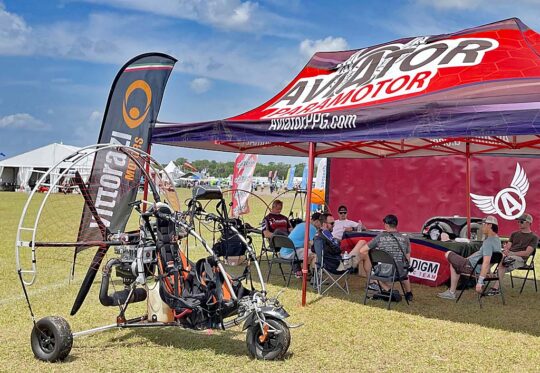
Around the planet, I have identified more than 66,000 light aircraft and 70-80% of them use a Rotax 9-series engine as their powerplant. Every other brand occupies the remaining 20-30% space, including some other fine and reliable engines. No matter how you spreadsheet the numbers, Rotax is far and away the dominant brand …although no longer in two-strokes.
What Is RMZ 500?
In the lead photo for the article, I hinted the return of the beloved Rotax 503. That was admittedly a bit deceptive but as you’ve probably never heard of the RMZ 500, I felt it was necessary to compare it to the popular former Rotax engine.
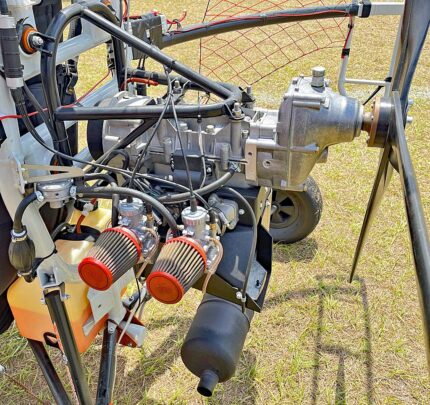
According to a British importer (using it for small hovercraft), “The RMZ 500 engine is piston ported with air-cooled cylinder heads and cylinders, utilizing a fan for cooling. The engine comes complete with a Ducati CDI unit [and is] also equipped with two 34mm Mikuni carburetors [with] fuel delivery supplied by an external pulse pump.” The UK site concludes, “Overall, [this gives] a great affordable and reliable replacement to a Rotax 503.”
Specifications: RMZ 500 is a gasoline, air-cooled, two-cylinder engine with 497 cc displacement; with a maximum engine output 50 horsepower at 6,000 rpm; and engine weight of 75 pounds not including exhaust.
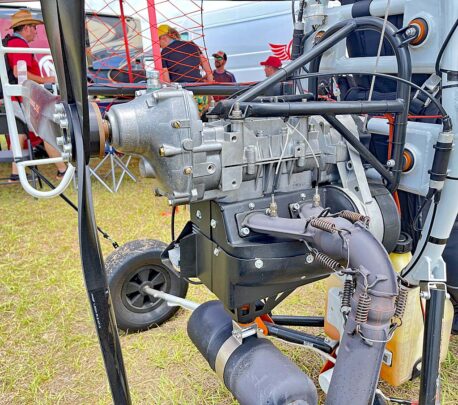
Eric related that his group has hundreds of hours on the trike undercarriage fitted with the RMZ 500. He reports the powerplant has been very trouble-free and he is enthusiastic about it, not merely to sell but to use in his busy flight school.
Exemptions Live On…
You probably thought all two-place exemptions expired when LSA arrived upon the scene in 2004. You’re partly correct.
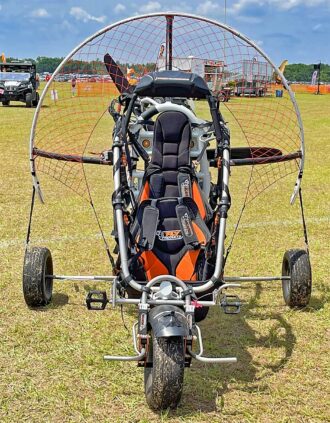
LSA supposedly fixed the problem — and in a few examples they did (Quicksilver, M-Squared, CGS Hawk, some trikes and powered parachutes). In a Special LSA ultralight-like aircraft, you could fly a passenger recreationally and you did not need to always perform instruction. Pilot licensure also was tightened. Unfortunately, the results were devastating to ultralight aviation — many instructors left the training business.
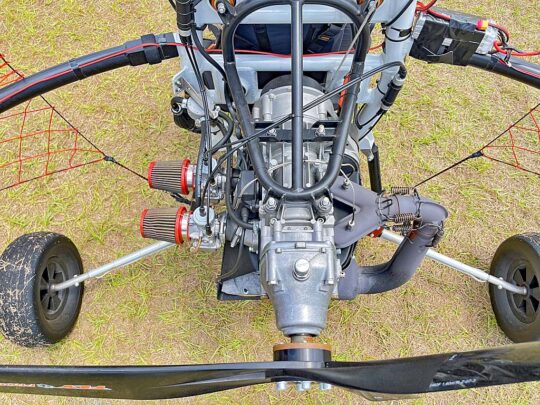
What even less people know is that powered paragliders (different than powered parachutes) were also permitted to keep their training exemption. FAA recognized that almost no one flew two-place hang gliders or paragliders or powered paragliders so they didn’t mandate a switch to costlier LSA.
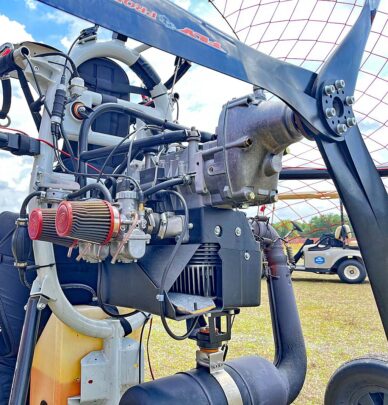
Presently revising their comprehensive website, Aviator Paramotor is based in central Florida at the well-known Lake Wales airport (X07). The central Florida company — with a satellite operation at the Dunnellon airport (X35) — offers a wide range of products that you may want to explore but as affordable aircraft go, these qualify. By casual estimate, the paramoter, a wing, and an undercarriage will run around $15,000 in ready-to-use form. Your final price may vary as options are available.
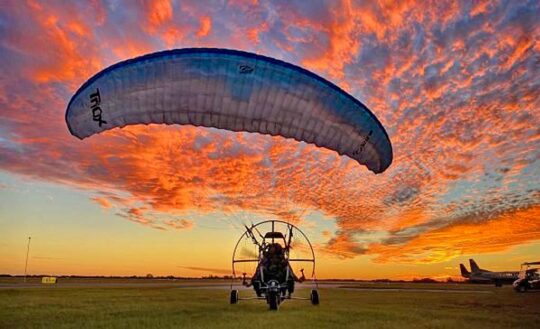
The Show — Eric’s team caught my attention a few years back as they put on a formation flying show using powered paragliders. They fly in surprisingly close formation and execute impressive maneuvers not so different than you are used to seeing with teams operating conventional aircraft. After decades of airshows, I admit I don’t always follow aerial acts closely but this bunch caught my attention. They’re good. Check them out yourself at Sun ‘n Fun 2022.



What happened to the RMZ500? It appears to have disappeared, Link on AviatorPPG.com for it just goes to a break in procedure for Rotax engines. Can’t find any real info on availability on the web either.
A curse on Rotax for abandoning their two stroke customers.
The RMZ500 comes from Russia. Given events of the last year, are you still surprised AviatorPPG has no new info?
Dan, this is an interesting article but how about backing up your statements regarding the 2-seat Part 103 with the Chapter and Verse of the relevant rules?
Facts are documentable, hearsay is not!
First, no 2-seat Part 103 exists in the USA so I don’t know how to address that comment.
Regarding the “Chapter and Verse,” it’s all right here on ByDanJohnson.com. To make them easier to find:
Part 103 regulation
Advistory Circular 103-6
Advisory Circular 103-7
The headline is: Two-Place PPGs.
PPGs are Part 103 vehicles, no?
You are describing Two-Place PPGs.
So I said 2-seat instead of Two-Place. Same thing, no?
From what I read, Part 103-6 is dated 1983, 103-7 is dated 1984.
103-7 13.c establishes that Two-Place vehicles can be used for flight training only with exception through AOPA, EAA and Hang Gliding Association.
But when 2004? came around that part was revoked, no?
Aviator Paramotor in it’s advertising states:
“If the pilot desires, and shows appropriate aptitude, you will learn how to safely and legally fly with passengers.
Full ground school discussion of tandem exemption regulations.
The importance of tandem safety, decision making, and redundancy.
How to set up the trike for safe tandems, as well as how to balance trikes for various passenger weights.
One-on-one tandem flight instruction with you as both passenger and pilot, with multiple instructors of varying weights and sizes.
Learn how to deliver a comfortable and informative introductory flight for your passengers, while making them feel extremely safe for the most enjoyable experience.”
Notice it says passenger, not student.
So people are led to believe that they can go to the training, buy a 2-seater and then fly with a passenger.
My question still is:
How is that legal? The FAA puts the onus on the person flying that vehicle but if that person has been told by their instructor that it is legal, how are they supposed to know the difference.
The FAA clearly states that it makes no difference what that person was told by anybody.
Only the person flying is responsible to the FAA.
There is another outfit in Florida that peddles 2 seat PPGs also telling prospective customers that they can fly with their wives
P.S. If the “Part 103 regulation” in your response was a link, I was unable to open it. The AC 103-6 and 7 link worked fine.
OK, Joachim, I misunderstood your point because the article delved into the arrangement with FAA (see “Exemptions Live On…”) that permits a two-place training vehicle under a long-held exemption to Part 103. However, this never applied to hauling passengers.
Regarding your comments about Aviator Paramotor’s advertising… I cannot comment on their sales literature but when I read what you wrote — “legally fly with passengers” — I also questioned the words but they could mean the student starts as a passenger, then learns, and can advance to become an instructor and teach others. Beyond that guess I don’t know their intent with that choice of words. Taking people for “rides” is not part of the exemption.
I am happy to consider any other questions but I cannot comment on a company’s promises. I do appreciate critical feedback but prefer to comment only on what I have written.
Thanks, also, for alerting me about the broken link. It is fixed now: Part 103 regulation
Dan, thank you for fixing the link to Part 103 regulations.
You wrote, “However, out of sight from most aviators, hang gliders were still permitted to do two-place instructional flying without needing a Special Airworthiness Certificates such as all LSA have. It has continued right on working well to this day as it had done for the decades before the big changeover.
What even less people know is that powered paragliders (different than powered parachutes) were also permitted to keep their training exemption.”
AC 103-6 makes no mentioning of training exemptions.
AC 103-7 talks about FAR 103 exemptions for all FAR 103, not just PPG and Hang Glider. AC 103-7 was written in 1984, with no discernable updates in 2004 when FAR 103 was updated. So I have to reason that it is obsolete.
FAR 103 makes no mention of two-place exemptions.
So let me ask my question again:
Where is a Two Place Exemption for training written in current applicable rules or regulations?
After all, that is the statement that you made in the original article.
Joachim
Here you go: from USPPA
Thank you so very much, Dan!
That explains it to me.
Joachim
GM Dan,
It has been 10 years since I’ve flown an ultralight, but now that I’m getting back in it, and researching the ultralight and LSA world, your name keeps coming up everywhere I look.
Thank you for your knowledge and sharing your experiences in putting together your newsletters. May your wings and wheels always have wind below them.
TY and have a great day.
Dave
This comment was edited for clarity. —DJ
The RMZ-500 is the same core engine as the Rotax 503F/503UL.
The exhaust used determines horsepower developed. All RMZ engines use a plain exhaust muffler. There is a guy on eBay, also out of Russia, who makes copies of Rotax UL exhaust for the 277UL, 377UL, 447UL, 503UL, fairly well priced.
The RMZ-500 on their website ranges in Russian RUB $117,043 = $1,534.90 USD to Russian RUB 124,673 = $1,634.96 USD. Price reflects single carb vs. dual carb, lil injection vs. non-oil onjection.
If you notice they also make a 250 Single 22 horsepower at 6000 rpm Russian RUB $84,318 = $1,106.32 USD, and 32 hp at 7000 rpm with a good tuned pipe, a 440/447, 500/503, 550F.
A new Rotax B Gear Drive in the USA will range from $835 to $1050.
(If you going to hang the engine upside down, Skidoo still makes a 550F and depending on carb size used can make from 58hp to 70hp. A stock 2004 Skidoo 550F with 34mm Carbs synoed 70hp at 7000 rpm. Later Engines came with 30mm Carbs and were rated 58hp.)
Different types of aircraft, trikes, paragliders all need different horsepower. For Part 103 and normal kitplanes I would use the simple 1Kw-for-10 kg rule to power for your planes MTOW. Like for the Lazair Ultralight, with an MTOW of 450 pounds = 204 kg / 10 kg = 20 Kw to Fly Well = 27.3 hp / 2 = 13.7 hp for each rngine needed to fly well. Most single-seat kit planes MTOW fall between 450 lbs (27.6 hp) and 660 lbs (40.1 hp).
More (in Russian language): Factory website
RMZ won’t ship engines to the USA; you have to find a backdoor.
Rich Gillen, thanks for the info assist! You sound very informed.
As the article notes, Aviator Paramotor is handling the import duties. They’ll deserve a nice markup for doing all the legwork and taking the financial risk.
Rich,
I know of people in Europe that order from companies in the U.S.A. that do not ship to Europe, so what they do is use a reshipper. You could probably do the same thing, register with a reshipper in Europe, order the RMZ500 and have it shipped to your account address in Europe that the Russian company will ship to, and then the reshipper will forward the package to you. Does it cost, yes…but you will have your engine.
Translated website: https://bydanjohnson.com/whats-affordable-in-2022-a-new-503-wheeled-carriages-and-two-place-ppgs/?fbclid=IwAR0MWuAHHJPOSOZ0_vqfJ16HZAWez-8v2vsuV7MSXy_PHNdzzIgk-JHzR9M
Oops: https://russneg-ru.translate.goog/catalog/dvigateli_dlya_snegokhodov/?_x_tr_sl=ru&_x_tr_tl=en&_x_tr_hl=en&_x_tr_pto=wapp
What is the cost of RMZ 500?
Some details remain, as the article indicates. However, Eric Farewell suggested in the realm of $5,000 if you buy a new Rotax B gearbox and muffler.
My fellow pilots flown RMZ, problem every second flight
Of the 66,000 light aircraft you mention, well over 6,000 of them -or about 10%- are powered by Jabiru engines. Great article featuring many forms of flying! Keep them coming!
Jabiru has certainly been a prominent supplier for many years. Continental has a good presence, too, and relative newcomers like UL Power may rise. While Rotax may dominate, consumers like choices. One size does not fit all.